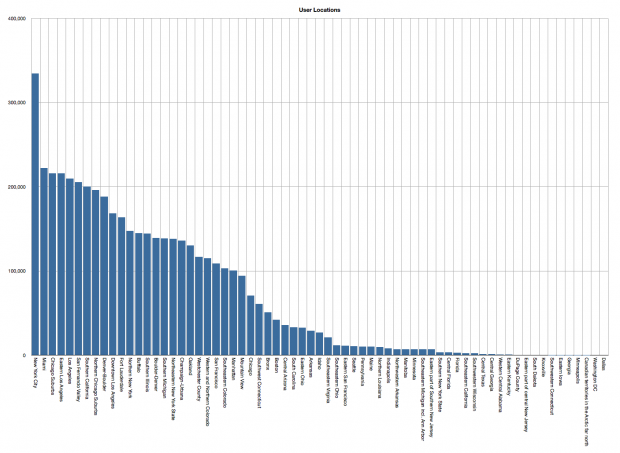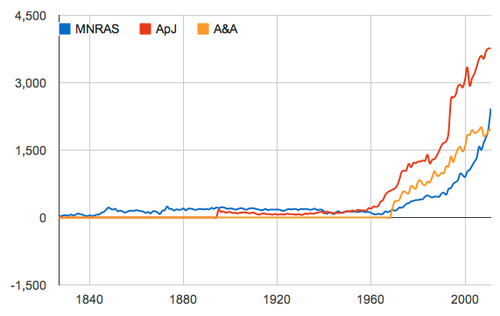Alasdair Allan
The Snapchat Leak
4.6 million phone numbers, is one of them yours?

The number of Snapchat users by geographic location. Users are predominately located in New York, San Francisco and the surrounding greater New York and Bay Areas.
While the site crumbled quickly under the weight of so many people trying to get to the leaked data—and has now been suspended—there isn’t really such a thing as putting the genie back in the bottle on the Internet.
Just before Christmas the Australian based Gibson Security published a report highlighting two exploits in the Snapchat API claiming that hackers could easily gain access to users’ personal data. Snapchat dismissed the report, responding that,
Theoretically, if someone were able to upload a huge set of phone numbers, like every number in an area code, or every possible number in the U.S., they could create a database of the results and match usernames to phone numbers that way.
Adding that they had various “safeguards” in place to make it difficult to do that. However it seems likely that—despite being explicitly mentioned in the initial report four months previously—none of these safeguards included rate limiting requests to their server, because someone seems to have taken them up on their offer.
3D printing from your fingertips
The 3Doodler is tapping a new market: People who want a 3D printer but can't afford one.
The 3Doodler is a 3D printer, but it’s a pen. This takes 3D printing and turns it on its head.
In fact the 3Doodler rejects quite a lot of what most people would consider necessary for it to be called a 3D printer. There is no three-axis control. There is no software. You can’t download a design and print an object. It strips 3D printing back to basics.
What there is, what it allows you to do, is make things. This is the history of printing going in reverse. It’s as if Gutenberg’s press was invented first, and then somebody came along afterwards and invented the fountain pen. Read more…
The inevitability of smart dust
Why general purpose computing will diffuse into our environment.
 I’ve put forward my opinion that desktop computing is dead on more than one occasion, and been soundly put in my place as a result almost every time. “Of course desktop computing isn’t dead — look at the analogy you’re drawing between the so called death of the mainframe and the death of the desktop. Mainframes aren’t dead, there are still plenty of them around!”
I’ve put forward my opinion that desktop computing is dead on more than one occasion, and been soundly put in my place as a result almost every time. “Of course desktop computing isn’t dead — look at the analogy you’re drawing between the so called death of the mainframe and the death of the desktop. Mainframes aren’t dead, there are still plenty of them around!”
Well, yes, that’s arguable. But most people, everyday people, don’t know that. It doesn’t matter if the paradigm survives if it’s not culturally acknowledged. Mainframe computing lives on, buried behind the scenes, backstage. As a platform it performs well, in its own niche. No doubt desktop computing is destined to live on, but similarly behind the scenes, and it’s already fading into the background.
The desktop will increasingly belong to niche users. Developers need them, at least for now and for the foreseeable future. But despite the prevalent view in Silicon Valley, the world does not consist of developers. Designers need screen real estate, but buttons and the entire desktop paradigm are a hack; I can foresee the day when the computing designers use will not even vaguely resemble today’s desktop machines.
For the rest of the world? Computing will almost inevitably diffuse out into our environment. Today’s mobile devices are transition devices, artifacts of our stage of technology progress. They too will eventually fade into their own niche. Replacement technologies, or rather user interfaces, like Google’s Project Glass are already on the horizon, and that’s just the beginning.
People never wanted computers; they wanted what computers could do for them. Almost inevitably the amount computers can do for us on their own, behind our backs, is increasing. But to do that, they need data, and to get data they need sensors. So the diffusion of general purpose computing out into our environment is inevitable. Read more…
Digging into the UDID data
The UDID story has conflicting theories, so the only real thing we have to work with is the data.
Over the weekend the hacker group Antisec released one million UDID records that they claim to have obtained from an FBI laptop using a Java vulnerability. In reply the FBI stated:
The FBI is aware of published reports alleging that an FBI laptop was compromised and private data regarding Apple UDIDs was exposed. At this time there is no evidence indicating that an FBI laptop was compromised or that the FBI either sought or obtained this data.
Of course that statement leaves a lot of leeway. It could be the agent’s personal laptop, and the data may well have been “property” of an another agency. The wording doesn’t even explicitly rule out the possibility that this was an agency laptop, they just say that right now they don’t have any evidence to suggest that it was.
This limited data release doesn’t have much impact, but the possible release of the full dataset, which is claimed to include names, addresses, phone numbers and other identifying information, is far more worrying.
While there are some almost dismissing the issue out of hand, the real issues here are: Where did the data originate? Which devices did it come from and what kind of users does this data represent? Is this data from a cross-section of the population, or a specifically targeted demographic? Does it originate within the law enforcement community, or from an external developer? What was the purpose of the data, and why was it collected?
With conflicting stories from all sides, the only thing we can believe is the data itself. The 40-character strings in the release at least look like UDID numbers, and anecdotally at least we have a third-party confirmation that this really is valid UDID data. We therefore have to proceed at this point as if this is real data. While there is a possibility that some, most, or all of the data is falsified, that’s looking unlikely from where we’re standing standing at the moment.
Mining the astronomical literature
A clever data project shows the promise of open and freely accessible academic literature.
There is a huge debate right now about making academic literature freely accessible and moving toward open access. But what would be possible if people stopped talking about it and just dug in and got on with it?
NASA’s Astrophysics Data System (ADS), hosted by the Smithsonian Astrophysical Observatory (SAO), has quietly been working away since the mid-’90s. Without much, if any, fanfare amongst the other disciplines, it has moved astronomers into a world where access to the literature is just a given. It’s something they don’t have to think about all that much.
The ADS service provides access to abstracts for virtually all of the astronomical literature. But it also provides access to the full text of more than half a million papers, going right back to the start of peer-reviewed journals in the 1800s. The service has links to online data archives, along with reference and citation information for each of the papers, and it’s all searchable and downloadable.

Number of papers published in the three main astronomy journals each year. CREDIT: Robert Simpson
The existence of the ADS, along with the arXiv pre-print server, has meant that most astronomers haven’t seen the inside of a brick-built library since the late 1990s.
It also makes astronomy almost uniquely well placed for interesting data mining experiments, experiments that hint at what the rest of academia could do if they followed astronomy’s lead. The fact that the discipline’s literature has been scanned, archived, indexed and catalogued, and placed behind a RESTful API makes it a treasure trove, both for hypothesis generation and sociological research.
They promised us flying cars
Tired of waiting, hackers and billionaires alike are building the future they want to see.
We may be living in the future, but it hasn’t entirely worked out how we were promised. I remember the predictions clearly: the 21st century was supposed to be full of self-driving cars, personal communicators, replicators and private space ships.
Except, of course, all that has come true. Google just got the first license to drive their cars entirely autonomously on public highways. Apple came along with the iPhone and changed everything. Three-dimensional printers have come out of the laboratories and into the home. And in a few short years, and from a standing start, Elon Musk and SpaceX has achieved what might otherwise have been thought impossible: late last year, SpaceX launched a spacecraft and returned it to Earth safely. Then they launched another, successfully docked it with the International Space Station, and then again returned it to Earth.
The SpaceX Dragon capsule is grappled and berthed to the Earth-facing port of the International Space Station’s Harmony module at 12:02 p.m. EDT, May 25, 2012. Credit: NASA/SpaceX
Right now there is a generation of high-tech tinkerers breaking the seals on proprietary technology and prototyping new ideas, which is leading to a rapid growth in innovation. The members of this generation, who are building open hardware instead of writing open software, seem to have come out of nowhere. Except, of course, they haven’t. Promised a future they couldn’t have, they’ve started to build it. The only difference between them and Elon Musk, Jeff Bezos, Sergey Brin, Larry Page and Steve Jobs is that those guys got to build bigger toys than the rest of us.
The dotcom billionaires are regular geeks just like us. They might be the best of us, or sometimes just the luckiest, but they grew up with the same dreams, and they’ve finally given up waiting for governments to build the future they were promised when they were kids. They’re going to build it for themselves.
Tertiary data: Big data’s hidden layer
Thoughts on the hidden data that's generated about us, rather than by us.
Big data isn't limited to multi-terabyte datasets or data markets. It also includes the hidden data you carry with you all the time and the growing data on your movements, contacts and social interactions.
Tertiary data: Big data's hidden layer
Thoughts on the hidden data that's generated about us, rather than by us.
Big data isn't limited to multi-terabyte datasets or data markets. It also includes the hidden data you carry with you all the time and the growing data on your movements, contacts and social interactions.
Fighting the next mobile war
Recent moves by Apple and Google could ignite the external accessories space.
While you'll likely interact with your smartphone tomorrow in much the same way you interacted with it today, it's quite possible that your smartphone will interact with the world in a very different way. The next mobile war has already begun.
Apple and a web-free cloud
Apple's approach to the cloud is business as usual, and that's what makes it interesting.
From custom chips, to the data centers backing its new iCloud effort, Apple is committed to controlling the end-user experience. The web has no place in their vision.
 Alasdair Allan is a Scientist, Author, Hacker and Tinkerer, and
Alasdair Allan is a Scientist, Author, Hacker and Tinkerer, and